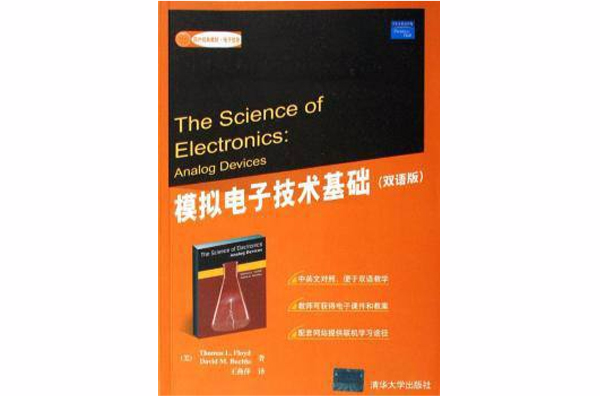《模擬電子技術基礎(雙語版)》是由清華大學出版社於2007年1月1日出版的圖書,作者是Thomas L.Floyd、David M.Buchla。
基本介紹
- 書名:模擬電子技術基礎(雙語版)
- 作者:Thomas L.Floyd、David M.Buchla
- 譯者:王燕萍
- ISBN:9787302142829
- 頁數:667
- 定價:59元
- 出版社:清華大學出版社
- 出版時間:2007-1-1
- 裝幀:平裝
- 開本:16
內容簡介,作者簡介,目錄,
內容簡介
結合理論和實踐,是模擬電路分析的理想教材。全書共12章,分別介紹模擬的概念、二極體、雙極型電晶體、場效應管、放大器、濾波器、穩壓器、振盪器和定時器、測量和控制電路、基本運放電路。書中穿插大量有趣的補充背景知識、豐富的例題、小節複習題和章末練習題。
作者簡介
Thomas L.Floyd擁有佛羅里達大學電氣工程學學士學位和電氣工程學碩士學位。他最初就職於德州儀器,擔任過多個項目的設計工程師。隨後加入馬丁?瑪麗埃塔公司,擔任高級工程師,從事飛彈制導系統和數字通信系統的研究。1973年,他加入大學,擔任全職教員,前後出版了多部著作。
譯者簡介:王燕萍,擁有南京航空大學學士和碩士學位。1988年任海軍大連艦艇學院電子系電子教研究室教員。1992年調至海軍廣州艦艇學院基礎部電子電工教研室工作。2004年轉業至廣州大學物理與電子工程學院,現任廣州大學物理與電子工程學院電子系副教授。長期從事《電路分析》、《模擬電路》和《數字電路》等課程的教學工作,有18年的教學經驗,對模擬電路等的教學體系非常熟悉並多次獲教學獎勵。代表譯著有《電子技術原理與套用——電路、數字系統、電子與電機(第3版)》。
譯者簡介:王燕萍,擁有南京航空大學學士和碩士學位。1988年任海軍大連艦艇學院電子系電子教研究室教員。1992年調至海軍廣州艦艇學院基礎部電子電工教研室工作。2004年轉業至廣州大學物理與電子工程學院,現任廣州大學物理與電子工程學院電子系副教授。長期從事《電路分析》、《模擬電路》和《數字電路》等課程的教學工作,有18年的教學經驗,對模擬電路等的教學體系非常熟悉並多次獲教學獎勵。代表譯著有《電子技術原理與套用——電路、數字系統、電子與電機(第3版)》。
考慮到模擬電路分析雙語教學的需要,本書不僅同時提供英文和參考譯文,還有專門的網站提供便於學生鞏固和複習的多種類型的測試題。選用本教材的教師還可獲得電子課件和電子教案。
目錄
CHAPTER 1 Analog Concepts
1.1 Devices and Quantities
1.2 Signals
1.3 Troubleshooting Analog Circuits
CHAPTER 2 Diodes and Applications
2.1 The Atomic Structure of Semiconductors
2.2 The PN Junction
2.3 Biasing the Semiconductor Diode
2.4 Diode Characteristics
2.5 Rectifier Circuits
2.6 Power Supply Fillters and Regulators
2.7 Troubleshooting a Power Supply
CHAPTER 3 Bipolar Junction Transistors
3.1 Structure of Bipolar Junction Transistors
3.2 BJT Bias Circuits
3.3 Amplifier Concepts and AC Considerations
3.4 Small-Signal Amplifiers
3.5 The Bipolar Transistor as a Switch
3.6 Transistor Packages and Terminal Identification
CHAPTER 5 Field-Effect Transistors
1.1 Devices and Quantities
1.2 Signals
1.3 Troubleshooting Analog Circuits
CHAPTER 2 Diodes and Applications
2.1 The Atomic Structure of Semiconductors
2.2 The PN Junction
2.3 Biasing the Semiconductor Diode
2.4 Diode Characteristics
2.5 Rectifier Circuits
2.6 Power Supply Fillters and Regulators
2.7 Troubleshooting a Power Supply
CHAPTER 3 Bipolar Junction Transistors
3.1 Structure of Bipolar Junction Transistors
3.2 BJT Bias Circuits
3.3 Amplifier Concepts and AC Considerations
3.4 Small-Signal Amplifiers
3.5 The Bipolar Transistor as a Switch
3.6 Transistor Packages and Terminal Identification
CHAPTER 5 Field-Effect Transistors

